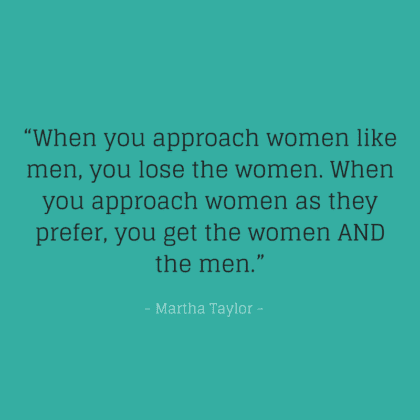Women give differently than men, but they definitely give. Take a look at these statistics:
- Single women are more likely than similarly-situated single men to give to charity. Women give significantly more than similarly-situated men at almost all income levels.
- Women have a significant impact on household giving patterns. For every $10,000 that the wife’s income increases, total household giving increases by more than 5 percent. In comparison, for every $10,000 the husband’s income increases, total household giving increases by 3 percent.
- The Million Dollar List compiled by the Lilly Family School of Philanthropy shows that between 2000 and 2013, 815 women made charitable gifts of $1 million or more. And I emphasize “or more,” as their giving total was $4,594,010,000.
So what exactly makes women give? How is their behavior different from the male donor we have traditionally focused on?
Five Important Aspects of Women’s Giving Behavior
-
Women Spread Out Their Giving
Research has found that, compared to men, women are more likely to spread their total giving across a number of organizations in smaller amounts. As a fundraiser looking only at women’s giving to your organization, you might conclude that they are not as philanthropic as men. That view misses the aggregate – and the potential. It also perpetuates the practice of focusing only on current donors, and those prospects like them, who are currently giving large amounts. How can the fact that women spread their giving influence your research approach? If you knew the aggregate amount she has given, how might that affect your rating for a potential ask or your solititation strategy?
-
Women Like to Work With Others When Supporting a Cause
Women are more inclined to work with others when supporting a cause. Melinda Gates, Co-Chair and Trustee of the Bill & Melinda Gates Foundation, highlighted this fact in her opening remarks at the Women’s Philanthropy Institute 2017 Symposium: “This is our strength as women — we cooperate, we collaborate, and we innovate to amplify our voices and accelerate change.”
Giving circles are popular with women as they allow for the pooling of contributions and collaborative decision-making. Understanding many women’s preference to collaborate, rather than act as individual philanthropists, is important when we consider that today’s fundraising practices often focus on individual strategies. How often do you invite a woman to a cultivation event and encourage her to bring someone from her network? Do you purposely design collective-solicitation strategies for groups of women of capacity, as well individual as strategies for each?
-
Women Need More Time And Information To Make Gift Decisions
Women take longer than men to make a gift decision – or any decision. Research indicates women consider a myriad of factors when choosing their next cars, making financial investments or simply coordinating the family calendar. In philanthropy, women also want many facts and interactions to ensure they are making a trustworthy choice with their gift. And they want to understand, up front, the likely impact. If you reframe engagement for women as part of due diligence, what different questions might you ask her along the path of connecting to your organization? How might engagement opportunities be designed to grow her passion for the mission as well as meet her desire for specific facts?
-
Women Expect Engagement Before Giving
In addition to their desire to understand an organization and their gift’s impact, women expect to be engaged before they are asked for a gift. For some women, that might take a single conversation, particularly if they are asked about their values or for their input. Others might prefer to give their time or expertise for a period of time before giving. Women often feel they are not being valued for all they have to offer when they are approached solely for a gift. Do you plan for multiple visits or interactions with a woman before a solicitation so you can learn what she has to offer beyond money? Are you authentic in asking for input when it is appropriate and sharing the impact of her support, whether it comes in the form of time, talent or treasure?
-
Women Gravitate Toward High-Impact Over High-Visibility Roles
Women (often unconsciously) look for high-impact volunteer roles over high-profile ones. At a 2013 meeting with the women volunteer leaders from Duke University, former Duke president Nannerl O. Keohane shared personal reflections about leadership and gender from her career in higher education. She noted that women are socialized to behave differently than men regarding leadership. Women often choose “behind-the-scenes” work where they can collaborate closely with others to make change, rather than high-profile roles like board chair or council president. This generalization certainly does not apply to all women; however, it is important to recognize that you may not “see” as many women raising their hands for high-visibility roles. If you want to grow women’s leadership in your organization, how can you ensure that these high-profile roles incorporate women’s desire to connect directly with others? How can you help connect the dots for women between high-visibility and high-impact?
Why Bother?
 After learning these aspects of women’s giving behaviors, you may be asking yourself, “Why bother? Working with women will take too long.” It takes time for a fundraiser to conduct deeper research, to explain and share information, to provide meaningful engagement opportunities and to guide women toward leadership. And time feels like the enemy in a fundraising environment with ever-increasing goals and scarce resources.
After learning these aspects of women’s giving behaviors, you may be asking yourself, “Why bother? Working with women will take too long.” It takes time for a fundraiser to conduct deeper research, to explain and share information, to provide meaningful engagement opportunities and to guide women toward leadership. And time feels like the enemy in a fundraising environment with ever-increasing goals and scarce resources.
If women’s greater inclination to give and significant capacity isn’t convincing enough, consider two additional reasons. First, when you gain a woman’s trust in your organization, her loyalty keeps her close to your mission AND she brings her network with her. The power of word of mouth, combined with women’s desire to collaborate closely with others, can translate into building your donor pipeline quickly with other donors who also will bring their networks. The results are exponential in giving and networking, vs. one gift at a time.
Moreover, when you meet women’s high standards, you are also meeting the demands of the men on your donor list. These days, more and more donors consider themselves “investors.” I’ve always remembered my colleague Martha Taylor’s words: “When you approach women like men, you lose the women. When you approach women as they prefer, you get the women AND the men.”
